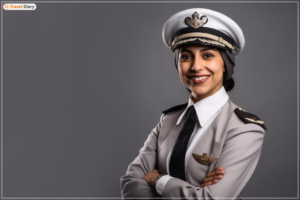Need a Guide on how to Become a Pilot . Read Further….
In India many young enthusiastic career minded students want to become a pilot and fly planes .After passing 12th exams, many students ask some common questions like
(A). What is the educational qualification and subject knowledge requirement to become a pilot
(B) What is the medical test required to become a pilot ?
(C)Is there any pilot training school to study for preparation of pilot exam in India ?
(D)Is there any flight training school to help become a commercial pilot ?
(E) What mandatory exam is required to be clear to get a commercial pilot license ?
(F) Which are the companies in aviation in India which recruit a commercial pilot ?
(G) What are the various job profiles associated with a pilot ?
(H) What is a commercial pilot’s salary ?
That is why in this article we are going to answer all these questions and clear all the doubts regarding pilot training after 12th. If you are also looking for answers to these questions then please read this blog till the end.

So, let’s get started
Who is a Pilot?& who can Become a Pilot..
Who can become a pilot and what does a pilot do ? A pilot is a highly trained and experienced professional responsible for the safe operation of aircraft. In addition to being experienced pilots, pilots must have extensive knowledge of aviation regulations, navigation systems and emergency procedures.
They play a vital role in ensuring the safety of passengers and cargo during flights. They specialize in different categories such as commercial, private or military aviation. In India , aspiring pilots usually undergo rigorous training through aviation academies or institutions approved by the Directorate General of Civil Aviation (DGCA). Because becoming a pilot requires dedication, academic qualifications ,clearance of pilot exam and gaining the necessary flight hours to obtain the required licenses.
Process to become a commercial pilot after 12th in India
Becoming a pilot in India after completing 12th involves a structured process and various steps. Here are the general steps you need to follow to make your dreams of becoming a pilot come true:
Step 1: Check your educational qualifications to become a pilot
You must complete your 10+2 school education with compulsory subjects in physics and mathematics. If you are from a non-scientific background, you can still become a commercial pilot.
How? Here is the solution:
If you don’t have Physics and Mathematics subjects in your 12th year and want to become a commercial pilot in India, you can do Physics and Mathematics from NIOS (National Institute of Open Education) to meet DGCA requirements.
You should focus on good academic performance as several flight training programs and airlines have eligibility criteria based on academic performance.
Step 2: DGCA medical examination to become a pilot
To begin the process of becoming a pilot, you must be physically and mentally fit and undergo a Class 2 medical examination conducted by DGCA-authorized medical examiners to ensure eligibility.
Candidates who want to pursue a pilot career in India require Class II medical certificate issued by DGCA. This medical examination can be taken at any time after the age of 10 and at least 16 years of age. This medical certificate is valid for two years.
Candidates holding a valid 2nd class medical certificate can apply to start the pilot training process at DGCA Ground School or Flight Training Centre. After obtaining a DGCA Class II medical certificate, you can process a Class I medical certificate.
Also Read:- DGCA Class 1 and Class 2 Medicals for Pilot – Guidehttps://www.topcrewaviation.com/dgca-class-1-and-class-2-medical-guide/
Step 3: Select pilot ground school for DGCA CPL subjects
To become a pilot, it is important to start with a strong foundation for a smooth pilot training journey. Enrolling in a pilot ground school is a key decision. People often say that anyone can fly, but being a good pilot means being dedicated to ground tasks.
Experienced pilot instructors often advise completing ground school before beginning flight training. DGCA allows unlimited attempts to complete ground school subjects, with exams held every month.
The duration of DGCA CPL Ground Classes can be approximately 4-6 months.
- The following subjects are in CPL Ground Classes:
1.Aviation regulations
2. Aviation meteorology
3. Air navigation
4. Technical general
5. Technical specifications
6. Radiotelephony (RTR-A)
Do a thorough Research and select a good ground school in India for ground studies. Consider factors such as reputation, equipment and location records. Experienced instructors and renowned DGCA academy who are experts in their respective fields can greatly improve your chances of clearing DGCA PPL/CPL exams in your very first attempt. After passing the DGCA exams, you can complete the 200 hours of required flying training in approximately six months. If you would like to know more about CPL Ground Classes and subjects, please do not hesitate to contact us today!
Step 4: Choose the best flight school to Become a Pilot to fly high
After passing the DGCA pilot exams, you should research a flight school to complete your 200 hours of flight training.
Choosing the right location for your CPL flying training is essential and an experienced organization with qualified instructors can make all the difference. Here is a checklist to help you choose the best flight training school:
Air Fleet: Make sure the flying club has top-of-the-line aircraft for the best flight training.
Experienced Instructors: Look for instructors with extensive experience.
Comprehensive training program: The training program should include briefings and debriefings before and after the lessons.
Infrastructure: Check facilities, including airstrips and accommodation.
Quality Equipment: Provide high quality equipment such as simulators, training materials and study materials.
A competitive yet enthusiastic environment: A place that fosters enthusiasm and helps you become the best commercial pilot you can be.
Before you decide, do a tour, ask and clear any doubts from their old students. Explore training methodology, curriculum, facilities, and other factors to make an informed decision about your pilot aspirations.
Step 5: Get your Commercial Pilot License (CPL)
Once you complete the above necessary steps and submit the required documents to the DGCA, if you meet their requirements, they will issue you a Commercial Pilot License (CPL). Clearing the DGCA exam and Obtaining a DGCA CPL is a significant achievement on your path to a career as a pilot. However, it is not the end of the road. Keep your pace, be prepared, and when the airlines start hiring, try to secure a seat in the airline cockpit. Keep working towards your goal of becoming an airline pilot .
Step 6: Commercial pilot type rating (if applicable)
If you plan to fly specific types of aircraft, you may need to complete additional training known as a type rating. A type rating is like a special certification for a pilot to fly a specific type of aircraft. It is a note on their license that shows what they are allowed to do and what restrictions they have when operating a particular type of aircraft. For example, this could be for a specific type of Airbus, such as the A320 or A380, or a specific Boeing model, such as the B737 or B777.
In short, achieving your dream of becoming a pilot after 12th grade means completing the necessary education, passing medical examinations, enrolling in a reputable Pilot Ground School ,clearing pilot exam and completing flight training. Earning your Commercial Pilot License (CPL) is a significant milestone, but it’s just the beginning. Be prepared for airline recruitment opportunities and consider further training such as type rating if required. Determination and preparation are critical to success on your journey to becoming a commercial pilot.
Pilot Jobs in Aviation Industry in India
Holding a commercial pilot license opens up great job opportunities with various airlines in India including:
Air India/Tata Airlines
SpiceJet Airlines
IndiGo Airlines
Alliance Air
Akasa Airlines
Vistara Airlines etc.
Also Read:- TOP 5 Indian Airlines in India
Job profiles for Pilots:
After clearing the pilot exam and obtaining Commercial Pilot License holder you can explore different job roles such as:
Co-pilot
Chief pilot
Commercial pilot
Airline pilot
Captain
Flight instructor
First officer
Chief Flight Instructor etc.
THE COST OF BECOMING A PILOT
The CPL course fees vary between institutions depending on factors such as ground instructor staff level , infrastructure provided and facilities for the aspirant. On an average, the CPL course fee ranges from ₹ 50 Lakhs to ₹ 70 Lakhs including the cost of type assessment.

PILOT SALARY: AFTER BECOMING A PILOT
In India, a commercial pilot can earn a monthly salary of ₹3,00,000 to ₹6,00,000. Salaries may vary between companies. Some other job benefits include:
Travel options
Free stays in 5-star hotels
Duty-free shopping privileges
Free tickets to travel around the world
Free collection and return services
Free refreshments etc.
Also Read:- Difference of Pilot Licenses between SPL, PPL and CPL in Indian Aviation
CONCLUSION
In conclusion, taking off on the journey of becoming a pilot after 12th class requires dedication, commitment and a structured approach. From meeting the educational requirements to obtaining the necessary medical certificates from the DGCA, enrolling in a reputed pilot ground school ,clearing the pilot exam and completing flight training, the journey to becoming an airline commercial pilot in India is very attractive as well as challenging .
Securing a Commercial Pilot License (CPL) is a significant milestone that opens the door to a range of career opportunities with leading airlines. In addition to initial success, continuous preparation and undertaking additional training such as a type rating is extremely important to succeed in the competitive environment of aviation.
The investment to become a pilot :
The investment to become a pilot ,both in terms of time and finances, is significant . But the potential rewards, including a competitive salary and exciting work benefits, make it a fulfilling and sought-after career path for aviation enthusiasts. Aspirant pilots should stay focused, stay informed and be aware of the opportunities that come their way . In India , the availability of air ambulances has become a crucial aspect of the emergency medical service. Whether transporting patients to specialized medical facilities or responding to critical situations in remote areas, air ambulances play a key role in providing timely and life-saving assistance.
GOOD LUCK , FUTURE AVIATORS!!!
https://youtu.be/AUmCnldDWz4?si=XAVibRLpXk5uQ1Td